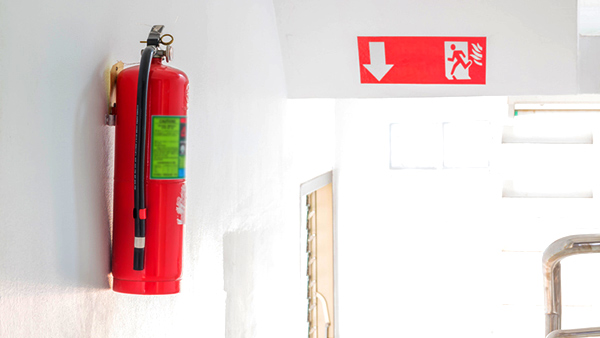
Place extinguishers so that you have a clear path to the exit.
Fire extinguishers can be an effective tool, but only when you select the correct type for your needs; install them in the most effective locations; and learn the proper way to use them. This three-part series covers the basics of fire extinguishers.
Part 2 of 3 –
Fire extinguishers are a critical component of your building’s overall fire protection system. With properly trained personnel and correctly placed and maintained extinguishers, these devices can suppress a fire in the early stages.
Fire extinguisher servicing contractors can advise you about placement and maintenance of extinguishers, but it’s beneficial to understand the basics.
FIRE EXTINGUISHER DISTRIBUTION
Extinguishers should be:
-
-
- located along the normal travel paths in your facility, including exit paths
- highly visibility
- easily accessible
- available for immediate use
-
Maximum travel distances to Class A or D extinguishers should not exceed 75 feet; Class B, 50 feet; and Class K, 30 feet. Maximum travel distances to Class C extinguishers, for electrical devices, should be no greater than for the same hazards (Class A or B) without electricity. Certain circumstances may require shorter travel distances; your fire extinguisher servicing contractor can advise you.
INSTALLATION OF PORTABLE FIRE EXTINGUISHERS
For the A rating, 1A is equal to one gallon of water being distributed from the unit. Class A hazard extinguishers are rated per A unit, 1A to 40A, and can protect a maximum floor area per unit. For a light hazard (office exposure), the floor area is 3,000 square feet; an ordinary hazard (retail store, light manufacturing), 1,500; and for extra hazard (car repair, wood working, spray painting or coating), 1,000. The maximum floor area of any extinguisher regardless of the A rating is 11,250 square feet.
For the B rating, 1B is equal to an actual fire test conducted with the extinguisher on one square foot of a burning liquid, one-quarter inch deep. Class B hazard extinguishers are rated per B unit, 5B to 80B, but do not have a maximum floor area per extinguisher.
Class C extinguishers are required for energized electrical equipment. They are classified as an A or B hazard, so they should be sized and located based on that designation.
Class D extinguishers are for fires involving combustible metals. The size of the unit is based on the specific combustible metal present, its physical particle size, the area to be covered and recommendations from the extinguisher manufacturer.
Class K extinguishers are designed for fires involving combustible cooking oils.
INSPECTION, MAINTENANCE AND RECHARGING
Portable fire extinguishers are required to be visually inspected when initially placed in service and monthly thereafter. This inspection ensures the extinguisher is still in its place and has:
-
-
- no obstructions
- intact safety seals
- no physical damage
-
If you discover a problem during monthly inspections, correct the issue immediately.
At least annually, an approved extinguisher servicing company should perform maintenance that includes a thorough examination of mechanical parts, extinguishing agent and expelling means of each unit. Certain extinguishers also require an internal examination, depending on the means of propelling the agent from the container.
All fire extinguishers must be pressure-tested to prevent unwanted failure of the cylinder. As a general rule, pressurized water, carbon dioxide and wet chemical extinguishers should be tested every five years; dry chemical extinguishers, every 12 years.
Fire extinguishers in the home should be placed strategically in the kitchen, workshop or garage and near an exit. Use one only when feasible to knock down a small fire, AFTER you have called 911 and moved everyone to safety. When using a home extinguisher, keep your back to a clear exit for easy escape. Remember that your first priority is to see that everyone gets out safely.
Part 1: Select the correct fire extinguisher for your needs
Part 3: Training: is key to correct fire extinguisher usage
This loss control information is advisory only. The author assumes no responsibility for management or control of loss control activities. Not all exposures are identified in this article.
